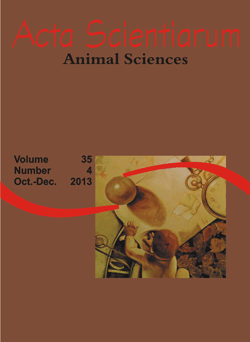<b>Direct and indirect effects of measures and reasons morphometric on the body yield of Nile tilapia, <i>Oreochromis niloticus</i></b> - doi: 10.4025/actascianimsci.v35i4.19807
Resumo
The study was carried out with the objective of verifying which measures and morphometric ratios are more directly related to the body yield of Nile tilapia, Oreochromis niloticus, in two weight classes. Data were analyzed from 257 specimens of tilapia divided into two weight classes: p1 = 400 to 599 g and p2 = 600 to 900 g. The morphometric measurements standard length (SL), head length (HL), body height (BH) and body width (BW), and the ratios of these measures (HL / SL, BH / SL, BW / SL, HL / BH, BW / BH, BW / HL) were evaluated. The following body yields were calculated: carcass (RCAR), fillet (RFILE) and head (RCAB). The data were initially submitted to the "stepwise" procedure to eliminate problems of multicollinearity among the morphometric variables, then the correlations between the dependent variables (body yield) and the independent variables (measured and morphometric relationships) were calculated. Later, these correlations were divided into direct and indirect effects through path analysis, and the direct and indirect contributions of each variable measured in percentage terms. The morphometric ratio BW/HL, for both weight classes, was the variable most highly correlated and with the highest direct effect on RFILE and RCAB, showing to be the most important morphometric variable studied for tilapia carcass trait determination.
Downloads
DECLARAÇÃO DE ORIGINALIDADE E DIREITOS AUTORAIS
Declaro que o presente artigo é original, não tendo sido submetido à publicação em qualquer outro periódico nacional ou internacional, quer seja em parte ou em sua totalidade.
Os direitos autorais pertencem exclusivamente aos autores. Os direitos de licenciamento utilizados pelo periódico é a licença Creative Commons Attribution 4.0 (CC BY 4.0): são permitidos o compartilhamento (cópia e distribuição do material em qualqer meio ou formato) e adaptação (remix, transformação e criação de material a partir do conteúdo assim licenciado para quaisquer fins, inclusive comerciais.
Recomenda-se a leitura desse link para maiores informações sobre o tema: fornecimento de créditos e referências de forma correta, entre outros detalhes cruciais para uso adequado do material licenciado.








































